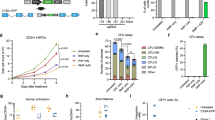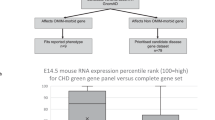Abstract
NADPH oxidase, a multi-subunit protein consisting of cytosolic components and the membrane-bound heterodimer, plays an instrumental role in host defence mechanisms of phagocytes. Genetic deficiency of the enzymatic complex results in an inherited disorder, chronic granulomatous disease (CGD), which is characterized by an impaired phagocyte microbicidal activity. X-Linked (XL) CGD results from a mutation in the CYBB gene encoding the gp91phox subunit, while autosomal recessive (AR) CGD is associated with mutations in one of the NCF1, NCF2 and CYBA genes that encode the p47phox, p67phox and p22phox subunits, respectively. In the study reported here, we investigated genetic defects underlying CGD in 15 Tunisian patients from 14 unrelated families. Haplotype analyses and homozygosity mapping with microsatellite markers around known CGD genes assigned the genetic defect to NCF1 in four patients, to NCF2 in four patients and to CYBA in two patients. However, one family with two CGD patients seemed not to link the genetic defect to any known AR-CGD genes. Mutation screening identified two novel mutations in NCF2 and CYBA in addition to the recurrent mutation, ΔGT, in NCF1 and a splice site mutation previously reported in a North African patient. Our results revealed the genetic and mutational heterogeneity of the AR recessive form of CGD in Tunisia.
Similar content being viewed by others
Log in or create a free account to read this content
Gain free access to this article, as well as selected content from this journal and more on nature.com
or
References
Ahlin A, de Boer M, Roos D, Leusen J, Smith CIE, Sundin U, Rabbani H, Palmbald J, Elinder G (1995) Prevalence, genetics and clinical presentation of chronic granulomatous disease in Sweden. Acta Paediatr 84:1386–1394
Babior BM (1999) NADPH oxidase: an update. Blood 93:1464–1476
Baehner RL, Nathan DG (1967) Leukocyte oxidase: defective activity in chronic granulomatous disease. Science 155:835–836
Barbouche MR, Sghiri R, Mellouli F, Boukhdir Y, Dellagi K, Bejaoui M (1999) Chronic septic granulomatous disease: 14 cases. Presse Med 28:2034–6
Bouchlaka C, Abdelhak S, Amouri A, Ben Abid H, Hadiji S, Frikha M, Ben Othman T, Amri F, Ayadi H, Hachicha M, Rebai A, Saad A, Dellagi K, Tunisian Fanconi Anemia Study Group (2003) Fanconi anemia in Tunisia: high prevalence of group A and identification of new FANCA mutations. J Hum Genet 48:352–361
Casimir CM, Bu-Ghanim HN, Rodaway AR, Bentley DL, Rowe P, Segal AW (1991) Autosomal recessive chronic granulomatous disease caused by deletion at a dinucleotide repeat. Proc Natl Acad Sci USA 88:2753–2757
Chanock SJ, Roesler J, Zhan S, Hopkins P, Lee P, Barrett DT, Christensen BL, Curnutte JT, Gorlach A (2000) Genomic structure of the human p47-phox (NCF1) gene. Blood Cells Mol Dis 26:37–46
Clark RA, Malech HL, Gallin JI, Nunoi H, Volpp BD, Pearson DW, Nauseef WM, Curnutte JT (1989) Genetic variants of chronic granulomatous disease: prevalence of deficiencies of two cytosolic components of the NADPH oxidase system. N Engl J Med 321:647–652
Cross AR, Noack D, Rae J, Curnutte JT, Heyworth PG (2000) Hematologically important mutations: the autosomal recessive forms of chronic granulomatous disease (first update). Blood Cells Mol Dis 26:561–565
Dib C, Faure S, Fizames C, Samson D, Drouot N, Vignal A, Millasseau P, Marc S, Hazan J, Seboun E, Lathrop M, Gyapay G, Morissette J, Weissenbach J (1996) A comprehensive genetic map of the human genome based on 5,264 microsatellites. Nature 380:152–154
Dinauer MC, Orkin SH (1992) Chronic granulomatous disease. Annu Rev Med 43:117–124
Dinauer MC, Orkin SH, Brown R, Jesaitis AJ, Parkos CA (1987) The glycoprotein encoded by the X-linked chronic granulomatous disease locus is a component of the neutrophil cytochrome b complex. Nature 327:717–720
Eikenboom JC, Vink T, Briet E, Sixma JJ, Reitsma PH (1994) Multiple substitutions in the von Willebrand factor gene that mimic the pseudogene sequence. Proc Natl Acad Sci USA 91:2221–2224
Elloumi-Zghal H, Barbouche MR, Chemli J, Bejaoui M, Harbi A, Snoussi N, Abdelhak S, Dellagi K (2002) Clinical and genetic heterogeneity of inherited autosomal recessive susceptibility to disseminated Mycobacterium bovis bacille calmette-guerin infection. J Infect Dis 185:1468–1475
Gorlach A, Lee PL, Roesler J, Hopkins PJ, Christensen B, Green ED, Chanock SJ, Curnutte JT (1997) A p47-phox pseudogene carries the most common mutation causing p47-phox- deficient chronic granulomatous disease. J Clin Invest 100:1907–1918
Hazan J, Dubay C, Pankowiak M P (1992) A genetic linkage map of human chromosome 20 composed entirely of microsatellite markers. Genomics 12:183–189
Helmberg A (1993) Twin genes and endocrine disease: CYP21 and CYP11B genes. Acta Endocrinol 129:97–108
Heyworth PG, Bohl BP, Bokoch GM, Curnutte JT (1994) Rac translocates independently of the neutrophil NADPH oxidase components p47phox and p67phox. Evidence for its interaction with flavocytochrome b 558. J Biol Chem 269:30749–30752
Hoodfar E, Teebi AS (1996) Genetic referrals of Middle Eastern origin in a western city: inbreeding and disease profile. J Med Genet 33:212–215
Horowitz M, Wilder S, Horowitz Z, Reiner O, Gelbart T, Beutler E (1989) The human glucocerebrosidase gene and pseudogene: structure and evolution. Genomics 4:87–96
Ishibashi F, Nunoi H, Endo F, Matsudal, Kanegasaki S (2000) Statistical and mutation al analysis of chronic granulomatous disease in Japan with special reference to gp91-phox and p22-phox deficiency. Hum Genet 106:473–481
Kenney RT, Malech HL, Epstein ND, Roberts RL, Leto TL (1993) Characterization of the p67phox gene: genomic organization and restriction fragment length polymorphism analysis for prenatal diagnosis in chronic granulomatous disease. Blood 82:3739–3744
Khlat M (1997) Endogamy in the Arab word. In: Teebi AS, Farag TI (eds) Genetic disorder among Arab populations. Oxford University Press, New York, pp 63–80
Knaus UG, Heyworth PG, Evans T, Curnutte JT, Bokoch GM (1991) Regulation of phagocyte oxygen radical production by the GTP-binding protein Rac 2. Science 254:1512–1515
Krawczak M, Cooper DN (1991) Gene deletions causing human genetic disease: mechanisms of mutagenesis and the role of the local DNA sequence environment. Hum Genet 86:425–441
Kwong CH, Malech HL, Rotrosen D, Leto TL (1993) Regulation of the human neutrophil NADPH oxidase by rho-related G-proteins. Biochemistry 32:5711–5717
Lander ES, Botstein D (1987) Homozygosity mapping: a way to map human recessive traits with the DNA of inbred children. Science 236:1567–1570
Morel F, Cohen Tanugi Cholley L, Brandolin G, Dianoux AC, Martel C, Champelovier P, Seigneurin JM, Francois P, Bost M, Vignais PV (1993) The O −2 generating oxidase of B lymphocytes: Epstein-Barr virus-immortalized B lymphocytes as a tool for the identification of defective components of the oxidase in chronic granulomatous disease. Biochim Biophys Acta 1182:101–109
Noack D, Rae J, Cross AR, Munoz J, Salmen S, Mendoza JA, Rossi N, Curnutte JT, Heyworth PG (1999) Autosomal recessive chronic granulomatous disease caused by novel mutations in NCF-2, the gene encoding the p67-phox component of phagocyte NADPH oxidase. Hum Genet 105:460–467
Noack D, Rae J, Cross AR, Ellis BA, Newburger PE, Curnutte JT, Heyworth PG (2001) Autosomal recessive chronic granulomatous disease caused by defects in NCF-1, the gene encoding the phagocyte p47-phox: mutations not arising in the NCF-1 pseudogenes. Blood 97:305–311
Riou S, El Younsi C., Chaabouni H (1989) Consanguinité dans la population du nord de la Tunisie. Tun Med 67:167–172
Roesler J, Curnutte JT, Rae J, Barrett D, Patino P, Chanock SJ, Goerlach A (2000) Recombination events between the p47-phox gene and its highly homologous pseudogenes are the main cause of autosomal recessive chronic granulomatous disease. Blood 95:2150–2156
Roos D, de Boer M, de Klein A, Bolscher BGJM, Weening RS (1993) Chronic granulomatous disease: mutations in cytochrome b558. Immunodeficiency 4:289–301
Roos D, de Boer M, Kuribayashi F, Meischl C, Weening RS, Segal AW, Ahlin A, Nemet K, Hossle JP, Bernatowska-Matuszkiewicz E, Middleton-Price H (1996) Mutations in the X-linked and autosomal recessive forms of chronic granulomatous disease. Blood 87:1663–1681
Royer-Pokora B, Kunkel LM, Monaco AP, Goff SC, Newburger PE, Baehner RL, Cole FS, Curnutte JT, Orkin SH (1986) Cloning the gene for an inherited human disorder chronic granulomatous disease on the basis of its chromosomal location. Nature 322:32–38
Smith DG, Adair GM (1996) Characterization of an apparent hotspot for spontaneous mutation in exon 5 of the Chinese hamster APRT gene. Mutat Res 352:87–96
Tanugi-Cholley LC, Issartel JP, Lunardi J, Freycon F, Morel F, Vignais PV (1995) A mutation located at the 5′ splice junction sequence of intron 3 in the p67-phox mRNA in a patient with chronic granulomatous disease. Blood 85:242–249
Tsunawaki S, Mizunari H, Nagata M, Tatsuzawa O, Kuratsuji T (1994) A novel cytosolic component, p40phox, of respiratory burst oxidase associates with p67phox and is absent in patients with chronic granulomatous disease who lack p67phox. Biochem Biophys Res Commun 199:1378–1387
Wientjes FB, Hsuan JJ, Totty NF, Segal AW (1993) p40phox, a third cytosolic component of the activation complex of the NADPH oxidase to contain src homology 3 domains. Biochem J 296:557–561
Acknowledgements
We gratefully acknowledge the cooperation of the patients and their families during this study. This work was funded by the Tunisian Ministry for Scientific and Technological Research and Development of Competencies.
Author information
Authors and Affiliations
Corresponding author
Rights and permissions
About this article
Cite this article
El Kares, R., Barbouche, M.R., Elloumi-Zghal, H. et al. Genetic and mutational heterogeneity of autosomal recessive chronic granulomatous disease in Tunisia. J Hum Genet 51, 887–895 (2006). https://doi.org/10.1007/s10038-006-0039-8
Received:
Accepted:
Published:
Issue date:
DOI: https://doi.org/10.1007/s10038-006-0039-8
Keywords
This article is cited by
-
Genetic, Immunological, and Clinical Features of the First Mexican Cohort of Patients with Chronic Granulomatous Disease
Journal of Clinical Immunology (2020)
-
Novel and recurrent AID mutations underlie prevalent autosomal recessive form of HIGM in consanguineous patients
Immunogenetics (2016)
-
Chronic Granulomatous Disease
The Indian Journal of Pediatrics (2016)
-
Role of Flow Cytometry in the Diagnosis of Chronic Granulomatous Disease: the Egyptian Experience
Journal of Clinical Immunology (2016)
-
Clinical, Immunological, and Molecular Findings of Patients with p47phox Defect Chronic Granulomatous Disease (CGD) in Indian Families
Journal of Clinical Immunology (2016)



